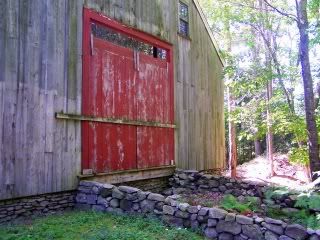|
 Re: Field stone mason
[Re: Mark Davidson]
#18158
02/14/09 04:08 PM Re: Field stone mason
[Re: Mark Davidson]
#18158
02/14/09 04:08 PM
|
Joined: Mar 2002
Posts: 961
Ken Hume

Member
|

Member
Joined: Mar 2002
Posts: 961 |
Hi Mark,
You are quite correct and I should not have said that the old ways are the best but sometimes old ways do have a better track record than new methods simply because they have stood the test of time. We are now paying a very heavy price here in the UK for the liberal application of Portland cement renders and mortars by the Victorians upon some of our oldest buildings. Attempts at undoing this work can result in serious damage to underlying fabric (brick & timber) and thus oft times it is just left in place knowing quite well that any underlying damage and decay is proceeding apace - undetected.
I am sure that some new things must be better than old. People talk about "keeping up with the times" and hence it might appear that the old ways are somehow valued less than new when with the passage of a little more time this might not actually be the case.
Regards
Ken Hume
Looking back to see the way ahead !
|
|
|
 Re: Field stone mason
[Re: Ken Hume]
#18159
02/14/09 05:22 PM Re: Field stone mason
[Re: Ken Hume]
#18159
02/14/09 05:22 PM
|
Joined: Nov 2003
Posts: 1,124
Mark Davidson

Member
|

Member
Joined: Nov 2003
Posts: 1,124 |
Thx for the recipes, mo.
When doing stone work, even with mortar the stones should always be set with the idea that if the mortar wears away the stones will stay in place. Again, flat stones will help.
Portland in the mix does give strength, and I think that has helped some of the more challenging stone repairs I've done to stay in place. In particular there are doorways in the barns in my area that were not built with care originally, and the sides of these doorways tend to fall in, the rebuild can take some patience to find the right stone or cut the right stone. Add to this that cattle will soon be using the doorway as part of thier fighting arena and one had better wish good luck to the repair.
I wish I could see the buildings you speak of Ken, a visit to the UK remains high on my list of dream vacations...
|
|
|
 Re: Field stone mason
[Re: Ken Hume]
#18160
02/14/09 05:25 PM Re: Field stone mason
[Re: Ken Hume]
#18160
02/14/09 05:25 PM
|
Joined: Mar 2008
Posts: 570
OurBarns1

Member
|

Member
Joined: Mar 2008
Posts: 570 |
Mark, I would like to visit the UK as well...amazing buildings. It would make for a wonderful vacation. Ken, Along that line, I wish I could join you for the recording projects you spoke of in this thread: http://www.tfguild.org/forums/ubbthreads.php?ubb=showflat&Number=18066&Main=18066#Post18066A guy here restores old barns and is a wonderful stonemason. The foundation on this oldie is a hybrid of dry-laid and mortared stone. He mortars the stones but keeps the outside face nearly mortar-free to resemble dry-laid:  This ramp is completely dry-laid:  As far as the "Old Ways," I like them so much I put it on my license plate  :  ...if only I had a TFG bumper sticker to put on this car !
Don Perkins
Member, TFG
to know the trees...
|
|
|
 Re: Field stone mason
[Re: Mark Davidson]
#18161
02/14/09 05:37 PM Re: Field stone mason
[Re: Mark Davidson]
#18161
02/14/09 05:37 PM
|
Joined: Oct 1999
Posts: 463
Roger Nair

Member
|

Member
Joined: Oct 1999
Posts: 463 |
Hi Mark, the ideal mortar mix is dependent on the space between the aggregates, the sand. You can measure that space easily. Take a sample of the sand and bake it to drive off the moisture. Place the sand in a known valume container, a liter for instance. Pour in water, measure the volume of water, until the water level reaches the top of the sand. The water volume represents the ideal volume of lime. Develope a ratio of lime to sand by volume. When mixing mortar, keep the ratio constant by using a bucket for a measure rathe than counting shovel scoops.
Use Type S Hydrated Lime and sharp builders sand. I would avoid silty river sand.
|
|
|
 Re: Field stone mason
[Re: Roger Nair]
#18165
02/15/09 12:03 PM Re: Field stone mason
[Re: Roger Nair]
#18165
02/15/09 12:03 PM
|
Joined: Dec 2007
Posts: 1,882
TIMBEAL

Member
|

Member
Joined: Dec 2007
Posts: 1,882 |
Very nice Roger. So it would appear the sand in Quebec takes on less water while the sand in Nova Scotia needs a tad more water. Why is that? Did some one just not bake the sample as long? Glacial deposited sand, it hasn't been worn down by the ages.
There are many who think the old ways are not as good as modern methods. It must be a mind set. They both have their +'s and -'s, it is our job to select the proper technique for the job at hand. Historic work should reuse the traditional methods and materials. There are always exceptions.
Tim
|
|
|
 Re: Field stone mason
[Re: TIMBEAL]
#18170
02/15/09 02:33 PM Re: Field stone mason
[Re: TIMBEAL]
#18170
02/15/09 02:33 PM
|
Joined: Oct 1999
Posts: 463
Roger Nair

Member
|

Member
Joined: Oct 1999
Posts: 463 |
The difference in mortar mixes can vary due to the size profile of the sand grains. Uniformly large grain sand will have more space between the grains than a mixture of grain sizes. Local differencs in the past, probably occur for a variety of reasons but I don't have any information. Sand is now an idustrial commodity, spec., washed and screened, vary different from what you can dig out of a bank.
Last edited by Roger Nair; 02/15/09 02:34 PM.
|
|
|
 Re: Field stone mason
[Re: Roger Nair]
#18190
02/16/09 12:17 PM Re: Field stone mason
[Re: Roger Nair]
#18190
02/16/09 12:17 PM
|
Joined: Dec 2007
Posts: 1,882
TIMBEAL

Member
|

Member
Joined: Dec 2007
Posts: 1,882 |
Was the sand used in the past washed and screened? Or is this a modern practice enacted to perfect the process?
Tim
|
|
|
 Re: Field stone mason
[Re: TIMBEAL]
#18202
02/16/09 10:03 PM Re: Field stone mason
[Re: TIMBEAL]
#18202
02/16/09 10:03 PM
|
Joined: Mar 2008
Posts: 570
OurBarns1

Member
|

Member
Joined: Mar 2008
Posts: 570 |
Tim,
"Washed and Screened" is a modern product from our point of view. It creates unifomity and removes foreign objects. For the most part, it's a modern gravel pit product...like Roger said, a by-the-yard "commodity."
Don Perkins
Member, TFG
to know the trees...
|
|
|
 Re: Field stone mason
[Re: Will Truax]
#18305
02/20/09 04:12 PM Re: Field stone mason
[Re: Will Truax]
#18305
02/20/09 04:12 PM
|
Joined: Nov 2006
Posts: 850
mo

Member
|

Member
Joined: Nov 2006
Posts: 850 |
to Will's point, if I remember correctly....
At least in brick work the lime based mortar is the sacrificial element in the brick mortar partnership. It is easier to restore mortar than brick. When you fix old brick work with Portland this relationship turns vice versa.
|
|
|
|
|